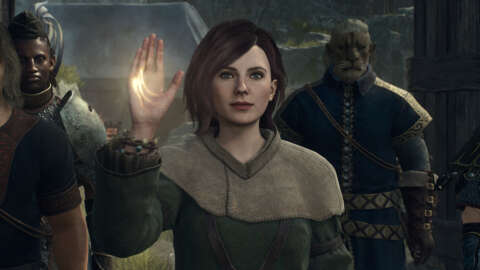Horror movie fans are eagerly awaiting the 2024 debut of The Strangers Trilogy, an ambitious expansion of the world first introduced in the 2008 sleeper hit, The Strangers. The buzz building began on the first day of New York Comic Con, as veteran director Renny Harlin and producer Courtney Solomon debuted the first footage from the first of three new Strangers films, officially titled The Strangers: Chapter 1.
You can read our full recap of that panel here.
'It's one film to us, it's just a giant film'
The film is headlined by Madelaine Petsch (Riverdale) and Froy Gutierrez (Cruel Summer). They play Maya and Ryan, a couple moving across the country to Oregon who, after taking a detour and spending the night in an Airbnb, are threatened by three strangers in masks.
All three films were shot at the same time, primarily in Slovakia, which made for a complicated production involving many moving parts, Solomon explained to IGN in an interview conducted immediately after the panel wrapped.
“It's one film to us, it's just a giant film. I don't want use this expression, but I always used to say it's kind of like the Titanic of horror movies. The arc that Maya’s character goes through [over the three films],” Solomon said, adding that there are practical and financial considerations that helped determine their unusual production schedule.
“I mean obviously there's budget, number one. You can actually stretch the money further by shooting them all at the same time," Harlin explaines. "If you go shoot three films years apart, you’ve got to re-prep those films. When you do it all together, you prep the entire giant film one time so you can put more money on the screen and genre horror movies, unless they're like I Am Legend or something like that, generally have more limited budgets than say, a Marvel movie. So we wanted to put it all on the screen.”
A wide net was put out to find the actors to portray Maya and Ryan.
"It's impossible to replicate what the original movie did,” Harlin said. “So we wanted to find our versions of the actors that we would believe in and who would be truthful to this movie and emotionally be the everyman and the everywoman that the audience can relate to and root for."
Petsch, a huge fan of Bryan Bertino’s 2008 movie, was the first person officially cast after Harlin and Solomon met with her and she came armed with dozens of pages with notes. “We found Madelaine first and then we just had to find a match for her. And that was a tough task because she's so special. So to find somebody that you would believe could be her boyfriend or fiancé, it's not an easy task.”
Solomon pointed out that they had been interested in signing Froy Gutierrez even before meeting with Petsch. But the crew decided that they did not want to make the final call on casting Ryan until they had found their Maya.
“We sort of had two or three guys [in mind] to play Ryan, but until we had Maya, we couldn’t actually make the Ryan decision,” he said. “We were being so annoying with casting Maya that we literally left [the Ryan casting] until the very, very end.”
Harlin’s past forays into horror have included supernatural tales such as A Nightmare on Elm Street 4: The Dream Master and Exorcist: The Beginning. The Strangers interested him because the terror in the film stems from a scenario that could happen in real life. “If it had been a supernatural movie, I'm sure I wouldn't have taken the [job],” Harlin admitted. “Because at this point I really wanted to do something that is real and I can believe in and I think that I can really do something special with.”
Harlin’s decades of experience making big-budget spectacles such as Die Hard 2, Cliffhanger and Deep Blue Sea proved invaluable during the making of The Strangers movies. “I think it helped a lot,” Harlin said. “Sometimes I wonder when, let's say some indie director who's just had a movie in Sundance, gets hired to do a giant studio movie. And I think that it's so unfair in a way. It's great that they get the opportunity but unfair to put them in a situation of dealing with something so huge and I don't know how they are able to handle it.”
“And so I think experience helps a lot and particularly in this kind of a situation where we are making three movies at the same time,” he continued. “It's all about having been there and knowing where the challenges and problems are going to be and anticipating them and preparing properly. And this really was a lot of preparation in terms of planning, but exactly how everything is going to be shot and where and when and being able to shoot them. Episode three in the morning and episode two in the afternoon, episode one the next morning. So a lot of logistics are involved. And then of course you want to keep your artist's hats on at all times and not get overwhelmed by the technical side of it.”
The complex production schedule forced the filmmaker to adjust, sometimes on the fly, to maintain the integrity of the story.
“There were definitely scenes that we shot sometimes in two or three different ways just because, even though we believed we were doing it the right way,” Harlin said, “We felt like with three movies, it'll be really dictated when we [edit] the whole movie together and we see how does the suspense and tension and some of those jump scares … how do they time out when it's all cut together basically into one four and a half hour movie? And so we definitely left some decision to be made in the editing room.”
But even a savvy filmmaker like Harlin was vexed on occasion, trying to navigate shooting scenes for different films on the same day.
“I have to be honest, this was the only movie I've ever made where the continuity person actually quit,” the director said. “I said to this person at one point, I just said in a kind way, I said, “You have to leave me alone. I know what I'm doing and I can't be bothered by every single detail every minute of the day, because I can't think and I can't make a movie.” And sometimes more important than the continuity is the emotion and the tension in the scene. But it was a tough job for the continuity person.”
“We had an expression on set,” Solomon added with a laugh. “We'll fix it in post.”
Mike Avila is a freelance writer at IGN







